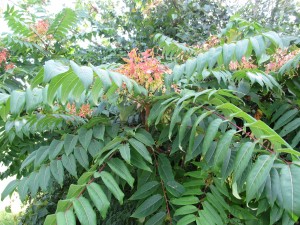Tree of heaven (Ailanthus altissima) is one of the most aggressive trees on planet Earth (USDA hardiness zones 4 to 8). This large tree, indigenous to China, was introduced in North America in 1748 and brought to New York City in 1820 as a street tree and a food source for silkworm caterpillars.
The tree tolerates a wide range of soils including poor ones, on sites where few other trees would survive. Growth rate is an incredible 3-5 feet in one season, eventually 40-60 feet high and 30-40 feet in spread with a loose, open canopy. The tree grows shorter in urban areas.
It prefers full sun, but can cope with partial shade. It is highly tolerant of deep shade and urban pollution. Roots sucker freely and can form large colonies or thickets that choke out native plants. It also self-seeds freely.
It grows almost anywhere, even from the cracks in concrete sidewalks or asphalt parking lots. Its roots damage pavement and building foundations. In most states, tree of heaven is commonly seen along roads and fencerows and is classified as a noxious weed in many states.
Its pinnately compound leaves are 1 to 4 feet in length which gives tree of heaven a lush tropical appearance. Basal leaflets display large gland-tipped teeth. Leaves and stems emit a foul stench when crunched.
Tree of heaven is primarily dioecious (separate male and female trees). Male flowers give off an unpleasant odor. It blooms June into July and flowers are greenish. Female trees produce reddish (maturing tan colored) single-winged samara fruits which are disseminated in early fall. A smooth medium gray bark covers the trunk(s) and main branches. Branch wood is weak and tall trees may self-destruct in strong winds.
Leaves are resistant to most urban air and ground pollutants. It has no serious insect or disease problems. Tree of heaven is difficult to eradicate. The tree drops loads of leaf and stem debris over lawn areas.


 Posted in
Posted in 
